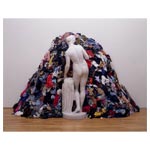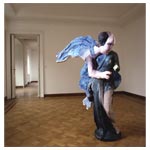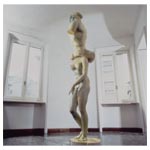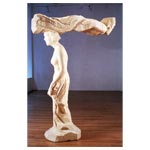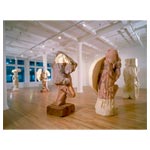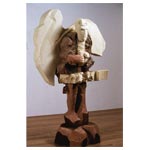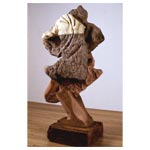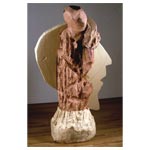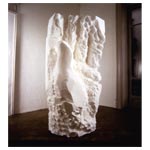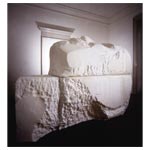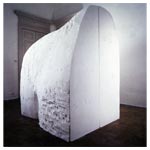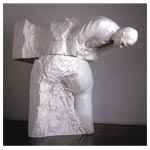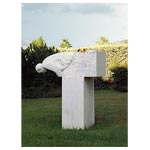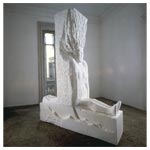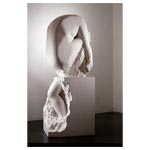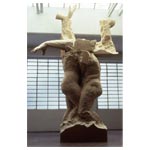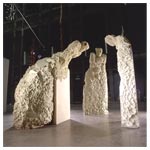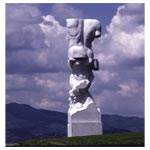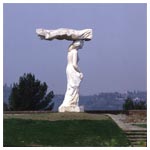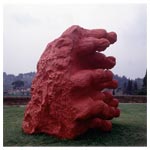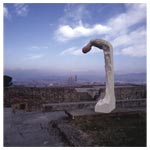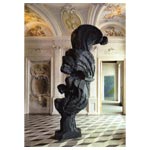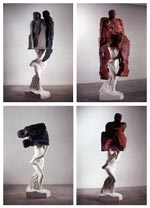Pistoletto has had a passion for sculpture ever since childhood. At the age of fourteen he bought an old wooden sculpture, paying for it in instalments. A 15th-century Madonna, it was his first acquisition for a collection that he would continue to assemble over the years. In 1965-66 this sculpture, placed inside a parallelepiped of orange plexiglass that partially covered it, became one of the Minus Objects.
In 1967, he started to use casts of classical sculptures for some of his works, such as the Venus of the Rags (1967), Gift of Mercury to the Mirror [Dono di Mercurio allo specchio] (1971) and The Etruscan [L'etrusco] (1976).
Works like The Annunciation [L'annunciazione] (1980), in which a second figure made of polyurethane was added to the cast of a statue, and The Giant [Il gigante] (1981), in which casts of several statues were superimposed, foreshadowed his subsequent production of true sculptures, carved out of rigid polyurethane, a material chosen for the speed with which it can be modeled. The first group of polyurethane sculptures, Nativity [La Natività], was made by the artist from polychrome blocks of the material for a solo exhibition at the Salvatore Ala Gallery in New York in November 1981. Later sculptures increasingly took on the appearance of an elaboration and condensation of fragments, taken as ‘found objects’ from the memory of the sculptural tradition, an aspect that is particularly evident in works like The Acrobat [L'acrobata] (1982) or Tree [Albero] (1983). In 1984, on the occasion of his solo exhibition at the Forte del Belvedere in Florence, he began to use marble to reproduce the polyurethane sculptures on a large scale. Polyurethane and marble would also be used together, one on top of the other, in the group of sculptures entitled The Four Seasons [Quattro stagioni] (1985).
“To turn my memory into a huge excursus, a long penetration into time as the decomposition and recomposition of sculpture (the social soul of art). I have rediscovered the term "sculpture", resurrecting the very gesture of "sculpting", that is "excavating". [...] I did it by excavating polyurethane, because this is a more rapid, more ironic material. I tackled sculpture as a dead, inert monumentality, in order to place it in an unstable condition, a lack of control, weight, or meaning, thereby resuscitating it, reviving it to focus on the present. [...] An artist has to have the courage to discard all the rubbish of sculptural figuration, which has also been the center of society in all eras. However, it is a rubbish that, like rags or rubbings, takes on a life of its own because nothing can be a corpse anymore. [...] I have destroyed all time by means of this work, which spans just a few short years. It is like turning all sculptures into a single sculpture.”
(M. Pistoletto interviewed by G. Celant, in G. Celant, Pistoletto, catalogue of the exhibition at the P.S. 1 Contemporary Art Center, New York, 1988, 186-87)
“There is a common spirit in the giant sculptures of Easter Island, the woodcarvings of the Middle Ages and the marble ones of Michelangelo, and that is what I want to find in sculpture again today. This term ‘sculpture’ focuses today on the question soul or not soul, that is center or not center, solid or hollow, god or not god. To monotheism I contrast in every fragment a center; I occupy the spatial and environmental void of the art of the seventies with the substance of a solid form; I transmute the explosive motion of dispersion into a dynamism that tends to bring together and unite the fragments of the modern deflagration.”
(M. Pistoletto interviewed by Bruno Corà in Costellazione, catalogue of the exhibition at the Galleria Giorgio Persano, Turin, 1983)
